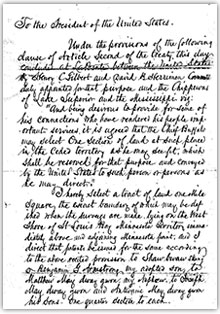Chief Buffalo
Chief Buffalo, known as Bichiki and Gichi-waishke, was a revered figure in the history of Ojibwe people in the western Lake Superior region. Born around 1759 at La Pointe on Madeline Island along the south shore of the lake, he was a member of the Loon clan. He became an eloquent leader for his people in dealings with the British and American governments.
In addition to the Treaty of 1854, which contained a provision setting aside a reserve of land for the chief in the future site of Duluth, Buffalo also signed the treaties of 1837, 1842, and 1847, which ceded land across what would become the territories and later states of Wisconsin and Minnesota. In 1852 Buffalo and others made a long journey to Washington, D.C. to protest the policies of Minnesota territorial officials who sought to remove all Ojibwe people from Wisconsin into Minnesota, centered on a government Indian agency at Sandy Lake. In part through Buffalo's actions policies were changed, resulting in the 1854 treaty, which created permanent homes in reservations throughout the region.
After his death in September 1855 Chief Buffalo was honored by federal officials by being buried in a tomb constructed at government expense at La Pointe.
Two busts in the U.S. Capitol in Washington, D.C., were long thought to be of Chief Buffalo of La Pointe, however recent research has shown that they are more likely to be of another Chief Buffalo from Leech Lake, Minnesota. The busts were based on a clay model by the Italian sculptor Francis Vincenti, done in the presence of the subject in February 1855. The date is what makes clear that the chief could not be Chief Buffalo of La Pointe, since the chief was not in Washington at that time. The only Chief Buffalo there then was the chief from Leech Lake, who came to negotiate the Treaty of February 22, 1855. For more information on the busts, see the U.S. Senate website
A thorough discussion of the problems of identifying the chief on whom the busts were modeled can be found here.
Copyright © 2022. All rights reserved.



